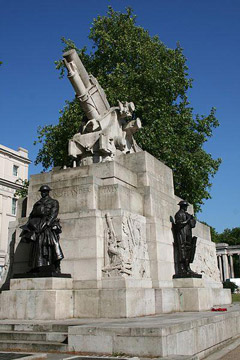With Flying Colours: Images & Colour Photographs of WW1
At the start of World War 1 color photography was in its infancy. From 1908 the Lumière brother’s autochrome method of color photography was patented and commercially available.
Autochrome
This process utilized glass plates coated with a gelatin emulsion over which a layer of tiny particles of potato starch, dyed green, orange or violet, had been dispersed. Red, blue and green light travels through this layer to the light sensitive emulsion. The plate was then developed to a negative image.
In 1914 the photographers who used this system usually had to be able to process the plates themselves.
Each exposure required at least 10 seconds; thus a tripod was a necessary piece of the bulky equipment that a photographer needed with him. He would of course have his camera, film and gas mask.
Because of the slow speed of the film action pictures could not be ‘snapped’, thus there are few color photos of battle engagement or actual combat. That is unless the pictures were processed using multiple imagery.
Most of the color photographs were produced by very few photographers. Here’s a list of a few more notable color photographers during the Great War:
- Hans Hildenbrand
- Hans Hildenbrand was an officer in the German army, one of 19 German photographers and the only one who used color, He documented the day-to-day life of the war.
- Baptiste Tournassoud
- Baptiste Tournassoud was a very talented Frenchman who in 1914 was using color photography, as well as black and white, to document the war in France.
- Jules Gervais-Courtellemont
- Jules Gervais-Courtellemont, a Frenchman, published in book form a series of colored pictures entitled The Battle of Marne and The Battle of Verdun.
- Frank Hurley
- Prior to the outbreak of WW1 Frank Hurley was an adventurous, professional photographer who enlisted into the Australian Imperial Forces as an official photographer and honorary captain in 1914. He was stationed in Europe, and travelled the Middle East and North Africa where he photographed prolifically. Hurley’s use of multiple negative imagery in order produce sensational pictures, gained him notoriety. He wanted his pictures to be dramatic, emotional and to tell stories. They illustrate the war in all of its colors.
Colorization of Black and White Pictures
Toning was a method used to produce an illusion of color in black and white photographs. The resulting prints are still considered monochromatic. The toners or pigments were added to the positive prints. This changed metallic silver in the emulsion to a silver salt which imparted differing color tones depending on the agent used. Thus the pigment sepia reduced silver to the sulfide and a ‘sepia’ print was obtained. In these pictures contrast is maintained whilst tones are enhanced

Royal Artillery Memorial in London, UK.
Paget Plate System
The Paget Plate system produced a color image by having a black and white positive looked at through a matrix of colored lines. The colors produced were not realistic and tended to be pale. This system was not in use for very long. However, The Australian War Memorial has a small collection of Paget prints taken by Frank Hurley.
Retouching
Retouching of photographs was done to enhance the pictures and for restoration purposes since the photographic chemicals and the papers used degenerated with time.
Monochromatic photographs were also hand tinted, a slow process.
Painting
Before the advent of photography pictorial imagery of war was created by artists often employed within the military. Photography was still in its infancy at the outbreak of WW1 thus artistry was utilized to depict the horrors of the battlefield, to record events, to be informative, for propaganda and portraiture; of the people of renown or those unknown.
The Royal Artillery Memorial in London sculpted by Charles Sargeant Jagger is a fine example of art inspired by war.
World War 1 Color Photographs and Images